My name is George.
I was named after my Great Grandfather, the lovely George R. Dale, who died many years before I was born. He served during the Second World War, then worked as a Gardner at Batley Park for most of his life. He was most likely named after his uncle, George Alfred Dale, who served during the Great War and would bear the ultimate sacrifice on 31 March 1918, aged barely 20, in a lonely hospital in Rouen. George Alfred Dale was himself likely named after his maternal Grandfather and my 5 x Great Grandfather, George Stead, whose fascinating and moving story began all the way back in 1787.
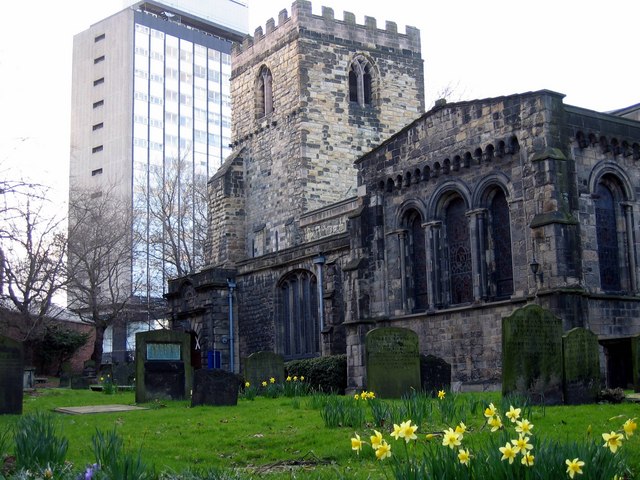
It specifically began on 18 January 1787, when he was born in Newcastle, the second son of William Stead. His mother was called Catherine, who was the daughter of local Collier George Smith. In contrast, George’s father was not a local man, as he was from the great and historic City of York and, for whatever reason, had ended up in 1780s Newcastle. Nevertheless, he somehow met Catherine, and they married in 1785 at St Andrew’s Church in what was Newcastle Town Centre. In the same year, they had a boy, their first child, William. Both boys were baptised at St Andrew’s Church, George, specifically on 1 April 1787.
William Stead was, by trade, a wheelwright, a person who makes/repairs wheels. The trade was arguably quite transferable and was likely in demand in most towns. Owing to this and William’s York roots, it is perhaps not a surprise that by 1791, the young family had left Newcastle and returned to York. Unfortunately, I know little about the family’s position before or after their move, nor precisely the reasons behind it. Was it a pull towards York because of William’s family links or better opportunities? Perhaps they were pushed away from Newcastle?
The earliest record of the move was William and Catherine’s third son’s baptism, whom they named John. He was baptised at St Margaret’s Church in Walmgate on 29 May 1791 and was born two days prior. The family now resided in Walmgate and would continue to do so for some years. After John’s birth came Thomas in 1793, Sarah in 1795, Margaret in 1797 and Matthew in 1799.
Only a few months before Matthew’s birth came the quite tragic death of Thomas Stead. He was possibly named after his paternal Grandfather, who was at that point still living. Thomas died, aged just six years, on 20 May 1799 and was buried two days later at St Margaret’s Church in Walmgate. Less than a year later came another death, that of young Sarah, who was just four years old. She died on 6 March 1800 and was also buried in the same churchyard as her brother two days after her death.
Clearly, the losses would have significantly affected the family. Many people perhaps unfairly dismiss infant mortality as commonplace in the past, but each unnecessary and cruel loss will have affected anyone considerably, just as it would today. What makes these deaths even more tragic is that many of the York Parish Registers were Dade registers at the time, so we can obtain the causes of death for both Thomas and Sarah. They died of what appears to be most likely ‘wearing’. Other possibilities seem to be ‘weaving’ or ‘weaning’, but at ages four and six, it is unlikely to be the latter. The actual definition of ‘wearing’ is something that is mentally or physically tiring. Perhaps then, it was a decaying ailment that appeared to slowly wear the two children out.
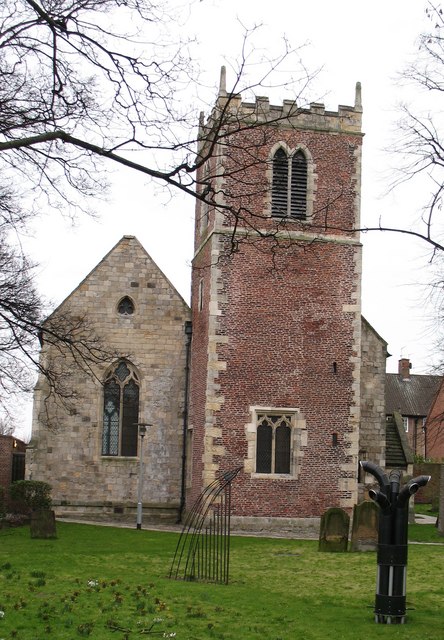
More children followed with the birth of Thomas in March 1802 and then Sarah in April 1804. Perhaps named quite poignantly after their late siblings. The Stead family by 1804 consisted of 10 children in total, with two who died as children sadly.
In late 1798, just before the deaths of Thomas and Sarah rocked the family, the eldest child, William, obtained an apprenticeship in basket making, being indentured to Richard Robinson for a period of seven years. George also followed his elder brother into this trade, being indentured to the same gentleman for the same period of time in 1802, just three years after his brother.
Of course, I don’t know the exact family dynamic, but one cannot help feeling that there was a strong bond between George and William Stead, the two eldest brothers born in Newcastle. Did George follow his brother’s steps because he was inspired by him, or was it down to less romantic reasons, perhaps along the lines of his father thinking it was the best for him?

Either way, tragedy struck the Stead family with William’s death of an unrecorded aliment on 13 August 1807. He was just 22 years old and had not yet married. He was buried two days later in the churchyard of St Margaret’s Church, Walmgate, just like his younger siblings. Of course, I do not aim to speak for how this affected the family, and the lack of information behind the death does not help put it in context. Was it quick, or did they watch him suffer? How did it affect George if he was close to his older brother? He was still indentured as an Apprentice; did he get to see William before he passed away?
Life continued either way, now with George as the eldest Stead sibling. He completed his apprenticeship, which finished in October 1809 and applied to become a Freeman of the City of York on 10 October 1809. He was residing in the Parish of St Crux at the time of his application and was admitted on 28 November that same year. As a result, we have a relatively rare sight from his freeman claim, namely his signature.
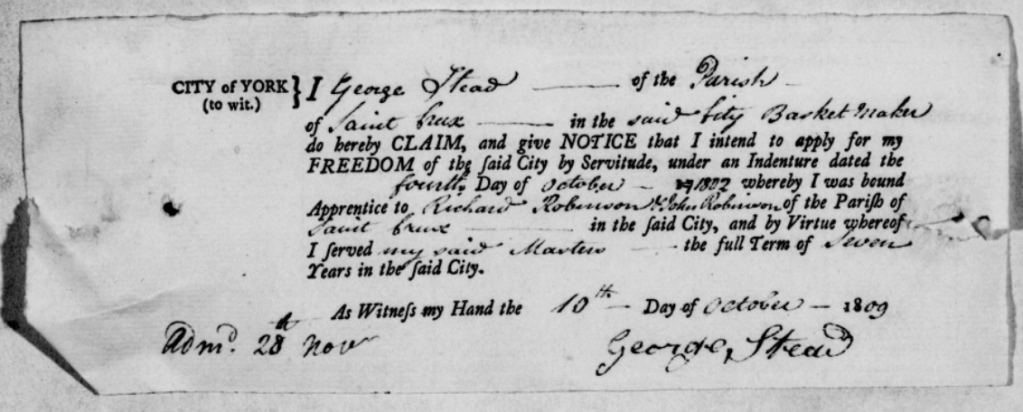
Just a few months after finishing his apprenticeship and becoming a Freeman of the City, George Stead married Mary Robinson at St Crux’s Church on 29 July 1810. Banns were read on the 8, 15 and 22 of July beforehand. She was a spinster who resided in the parish, as did George. Unfortunately, I know little about Mary, barring her birth being circa 1788. Still, I feel it is likely a possibility she could have been connected to the mysterious Richard Robinson, who was George’s master in his apprenticeship.
The honeymoon period was tainted by the death of George’s mother, Catherine, on 30 December 1810, aged just 46. Her official cause of death was reportedly “decline”. However, just about nine months after the death came a new generation as George Stead’s first child was born on 24 September 1811. He was named William, likely after his Grandfather and late Uncle. Was the new family to break with the losses of the old?
Frankly, they were not. I cannot find a burial record for William, but George and Mary had another boy called William in 1813, so their firstborn had likely passed away. By the second son’s birth, they had moved onto Fossgate and would remain there for some years. I am unsure what exactly happened to the second son, William, as George would many years later have another child called William, so again there is the possibility he also passed away. Next came two twin daughters, Elizabeth and Mary, who were baptised on 29 April 1817. Mary was buried on 4 May 1817, and Elizabeth was buried on 11 May 1817. Words can’t quite describe all these tragic losses. Then came another, at just 30 or so, the woman who George married a mere eight years or so ago, Mary, died in October 1818.
George had literally now lost nearly everyone.

A tragic ending however can birth a new beginning, and George Stead married Jane Lolley, my 5 x Great Grandmother, at All Saint’s Pavement Church on 31 January 1821. The Church is quite special to me for a few reasons, the main being the strong ancestral connection I have to it, and I have visited it many times when visiting York. Their first child, my 4 x Great Grandmother, Mary Stead, was baptised at St Crux’s Church on 20 December 1821. A sister followed, in early 1824, named Elizabeth. Like her late elder half-sister, she sadly died aged 14 months in April 1825. Then just a few years later, in July 1827, Jane herself passed away aged 33.
In late 1829, William, George’s father, the stalwart figure throughout George’s life of loss, passed away aged 63. As his funeral took place, and as his father’s body was interred at St Denys, Walmgate, one can only imagine what George felt. He had survived at least three siblings, including his elder brother, both parents, two wives and possibly four or five children. He was aged just 42 or so. What more could he possibly take?
George wasn’t alone – he had Mary, his young daughter. Their life for the next decade or so is quite fuzzy simply due to a lack of records. In 1838 this ends as George Stead gets married for the third time. He was still at work as a Basket Maker, as he had been for the last 51 years of his life. He resided on Regent Street, and possibly his daughter Mary also lived with him. His marriage was to Elizabeth Nolton, aged 32 or so, and occurred at St Lawrence’s Church on 21 July 1838.
The cloud of mist returns as George’s movements immediately after his marriage are quite unclear. The couple welcomed their first child in 1839, and he was called William. His baptism record in June of that year first records the couple residing at Pilgrim Street. Then came Ann in early 1841. She died only an infant, in the September quarter of the same year. However, she is recorded as living with her mother in that year’s census at the Pilgrim Street address. George Stead, his 20-year-old daughter and youngest boy, William, are not recorded living with Elizabeth and Ann, nor can their record be found at the time of writing.
The loss of little Ann was perhaps an unwelcome reminder of his past, but more children followed – Margaret in 1842, George in 1844, and Elizabeth Ann in 1846. It is worth noting that by the birth of Elizabeth Ann, George was nearing 60 years of age. At the time of his birth, back in 1787, life expectancy was around 39 years, and by the 1840s had only changed marginally. Sure, it was skewed a little by high infant mortality rates, but George was clearly living somewhat on borrowed time. However, from what can be seen of George’s life so far, it is clear he wasn’t one to give up easily.

In 1851, aged about 65, he is recorded as residing at 9 Pilgrim Street. He still continues in his trade as a basket maker, and it appears that his son William, aged 11, also followed him into it. His younger children also remain living with him and Elizabeth. Mary, his daughter, born in the 1820s, married my 4 x Great Grandfather, William Dale, son of the well-respected hairdresser William Dale, in 1844 and so now had moved out if she had not already. Their marriage was witnessed by two Robinsons – any connection to George’s old Apprentice Master?
Sadly, not much is known, up until 1861. Again, even then, it is just the year’s census confirming that George and his family remained living on Pilgrim Street. Elizabeth Ann Stead is no longer living with the family, but there is no indication she had passed away by that point. William worked as a Whitesmith, George junior, a confectioner and Margaret worked as a dressmaker. George senior’s longevity, aged 73, was remarkable compared to society generally and also his family’s experiences.
Longevity is not immortality, however.
George Stead became ill in about 1864 with cancer, specifically, the quite horrific-sounding Cancer of the Rectum. Especially considering medical knowledge and capabilities at the time and George’s social class, it is perhaps a miracle but also a curse that he managed to live with for two years. Is this possibility indicative of his fighting character lasting up until the end?
However, this time, the fight was in vain as George passed away, aged an incredibly impressive 79 years, on 12 June 1866, at the family home of 9 Pilgrim Street, Clifton, York. He outlived countless siblings, children and other family members but likely many friends and acquaintances. In addition, he could claim connections to two of the great towns of the north, York and Newcastle. Ultimately, despite relentless loss and hardship, he survived and fought up until his last breath.

This perseverance did not die with George in 1866. His eldest daughter Mary lived until she was 86 and died in 1908. Her son, Alfred, fought throughout his shorter life but kept the name George alive by naming his youngest son George Alfred. As I have previously mentioned, George Alfred Dale brought the fighting spirit to France and Flanders and gave up everything for King and Country. His Nephew, my Great Grandfather, George R. Dale, also held the fighting spirit in France during the Second World War and then channelled it into kindness. Then we come to me, and I will not be the judge of my own character. However, it is a great privilege to carry the blood and name of George Stead and all those mentioned in this paragraph.
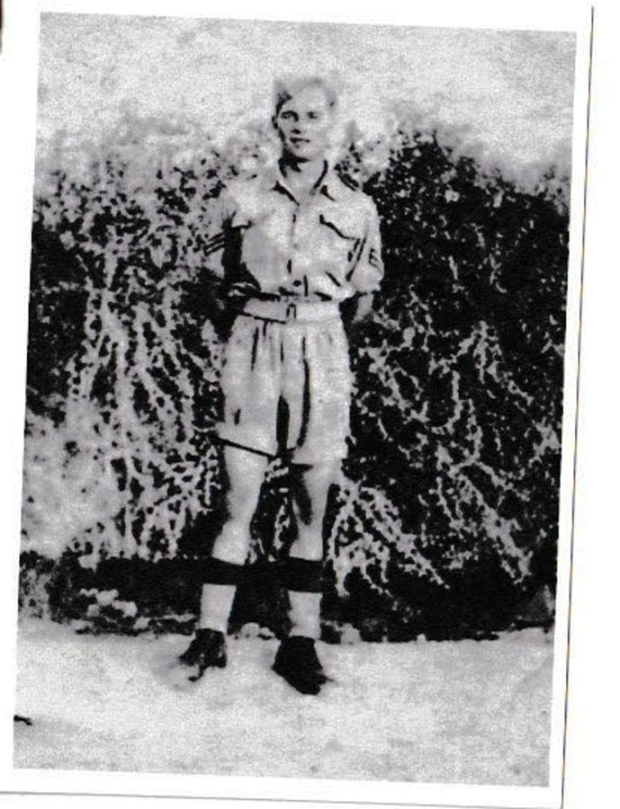
79 years of loss and labour ended in 1866 but is remembered in November 2022, nearing 213 years since he became a Freeman of the City of York and began his adult life. His unmarked public grave, hidden by that of a Lord Mayor’s, in York Cemetery, was also visited again 57,028 days after his death, when I was able, on Yorkshire Day 2022, to truly remember and reflect upon his remarkable life.
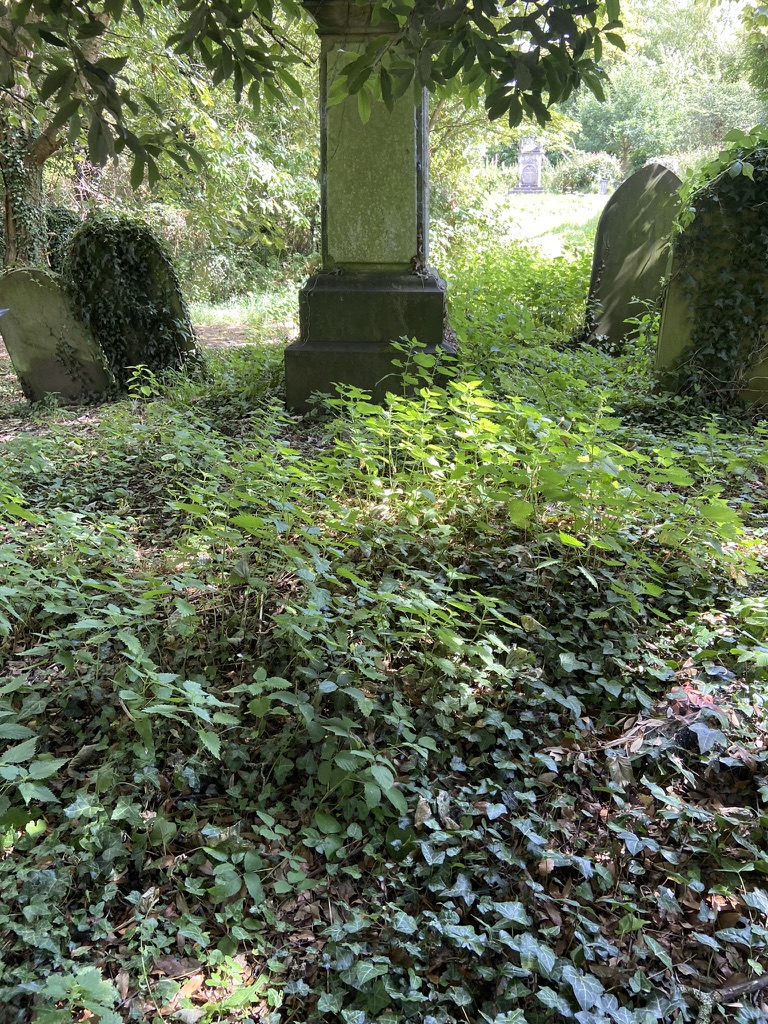
In memory of my remarkable Great Great Great Great Great Grandfather, George Stead.
I hope that you found some peace in death.

Leave a reply to Dana Akey Cancel reply